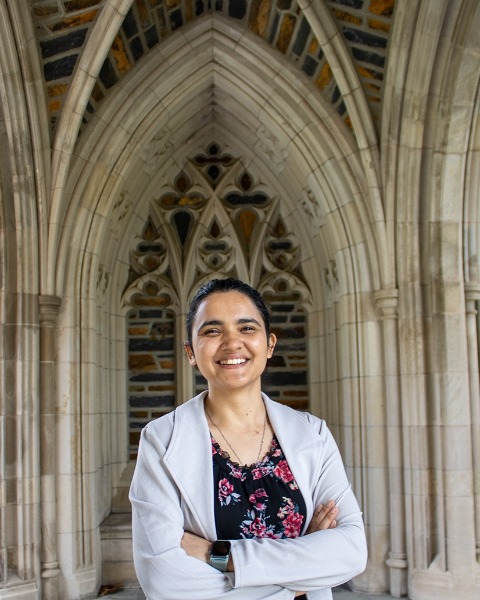Biomaterials
(A-21) Invitro Diffusion of E. coli and S. aureus Green Fluorescent Protein (GFP) Translocation in the 3D Printed Vascular Graft Material
Friday, October 13, 2023
9:30 AM - 10:30 AM PDT
Location: Exhibit Hall - Row A - Poster # 21

Ashma Sharma, PhD
Post Doctorate
Duke University
Durham, North Carolina, United States- AJ
A- Andrew D Jones
Assistant Professor
Duke University
Durham, North Carolina, United States - JP
Presenting Author(s)
Primary Investigator(s)
Last Author(s)
Introduction:: Depending on the surgical site and duration of the surgical process, vascular graft infection occurs in 0.6 - 6% of all vascular surgeries, typically after 30 days. Currently, vascular graft infection is associated with 20% of the mortality rate and approximately $640 million of cost burden in the USA. Adherence, invasion, and translocation of bacteria on vascular grafts are the major factors leading to vascular graft infection that plays a critical role in graft rejection and increase in mortality rate. This study aimed to investigate bacterial translocation to understand the nature of bacterial infection in synthetically produced vascular grafts. This study also leveraged a unique method to 3D bio-print a structure and determine bacterial growth along with its translocation.
Materials and Methods:: In this study, we enumerated E. coli green fluorescent protein (GFP) and S. aureus GFP, which is a commonly isolated bacteria in the vascular graft. Three biological replicates of the 3D-printed cylindrical construct of GelMA A (cellink) and alginate hydrogel were used for this study. The construct was injected with E. coli GFP and S. aureus GFP in a Difco ampicillin solution and immersed in Difco ampicillin media. The bacterial growth was evaluated every 0, 2, 4, and 6 hours post-inoculation. The 3D image obtained from confocal microscopy was further analyzed using image J to calculate the number of bacteria. The data obtained from the image was used to model the diffusion coefficient, which was based on Fick’s second law of diffusion equation:
dϕ/dt = D(d2ϕ/dx2). ; Where D = diffusivity, ϕ= concentration and x = position
Results, Conclusions, and Discussions:: Bacterial growth was quantified using log CFU/mL and confocal microscopy images to better understand the bacterial attachment, growth, and translocation through the 3D printed alginate and GelMA A bio-ink. The live dead staining method was also used to quantify bacterial growth. Results showed that the number of live bacteria was maximum at 4 hours compared to 6 hours and 2 hours in both alginate and GelMA A. The diffusion coefficient also followed a higher diffusion at 4 hours and decrement of bacteria at 6 hours for all bio-ink and for both bacteria. Both S. aureus and E. coli bacteria were diffusing, proliferating, and dying in all substrates.
Acknowledgements (Optional): :
References (Optional): :
Materials and Methods:: In this study, we enumerated E. coli green fluorescent protein (GFP) and S. aureus GFP, which is a commonly isolated bacteria in the vascular graft. Three biological replicates of the 3D-printed cylindrical construct of GelMA A (cellink) and alginate hydrogel were used for this study. The construct was injected with E. coli GFP and S. aureus GFP in a Difco ampicillin solution and immersed in Difco ampicillin media. The bacterial growth was evaluated every 0, 2, 4, and 6 hours post-inoculation. The 3D image obtained from confocal microscopy was further analyzed using image J to calculate the number of bacteria. The data obtained from the image was used to model the diffusion coefficient, which was based on Fick’s second law of diffusion equation:
dϕ/dt = D(d2ϕ/dx2). ; Where D = diffusivity, ϕ= concentration and x = position
Results, Conclusions, and Discussions:: Bacterial growth was quantified using log CFU/mL and confocal microscopy images to better understand the bacterial attachment, growth, and translocation through the 3D printed alginate and GelMA A bio-ink. The live dead staining method was also used to quantify bacterial growth. Results showed that the number of live bacteria was maximum at 4 hours compared to 6 hours and 2 hours in both alginate and GelMA A. The diffusion coefficient also followed a higher diffusion at 4 hours and decrement of bacteria at 6 hours for all bio-ink and for both bacteria. Both S. aureus and E. coli bacteria were diffusing, proliferating, and dying in all substrates.
Acknowledgements (Optional): :
References (Optional): :
